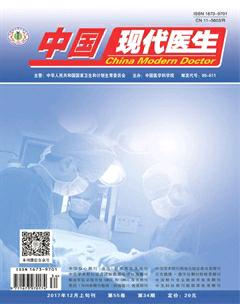隐丹参酮诱导乳腺癌 MDA—MB—231 细胞凋亡的研究
周南阳+赵虹
[摘要] 目的 探討隐丹参酮对乳腺癌MDA-MB-231细胞凋亡的影响及其机制。 方法 用不同浓度的隐丹参酮处理MDA-MB-231细胞24 h。采用 MTT、流式细胞术检测不同浓度隐丹参酮对MDA-MB-231细胞活性、凋亡的影响。采用Western blot检测MDA-MB-231细胞中Bcl-2、Bax、Caspase-3蛋白表达水平。 结果 与0 μmol/L对照组相比,10 μmol/L、20 μmol/L、40 μmol/L、80 μmol/L隐丹参酮组MDA-MB-231细胞存活率显著降低,且呈剂量依赖(P<0.05)。流式细胞仪检测显示隐丹参酮在20 μmol/L浓度时MDA-MB-231细胞凋亡率为(6.34±0.52)%,与对照组(6.09±0.76)%相比无统计学差异(P>0.05)。在40 μmol/L、80 μmol/L浓度时MDA-MB-231细胞凋亡率分别是(18.74±0.65)%、(28.04±3.08)%,与对照组相比有统计学差异(P<0.05),且两浓度组之间相比差异亦有统计学意义(P<0.05)。Western blot结果显示,与对照组相比,隐丹参酮在40 μmol/L、80 μmol/L浓度时,MDA-MB-231细胞内抗凋亡蛋白Bcl-2表达显著下调(P<0.05),同时,促凋亡蛋白Bax、Caspase-3表达显著增加(P<0.05)。 结论 隐丹参酮可诱导三阴乳腺癌MDA-MB-231 细胞凋亡,其机制可能与激活Bax、Caspase-3和抑制Bcl-2等凋亡调控基因有关。
[关键词] 隐丹参酮;乳腺癌;MDA-MB-231细胞;凋亡
[中图分类号] R273 [文献标识码] A [文章编号] 1673-9701(2017)34-0038-05
Study of cryptotanshinone inducing apoptosis of breast cancer MDA-MB-231 cells
ZHOU Nanyang1 ZHAO Hong2
1.Department of Traditional Chinese Medicine, Hangzhou Obstetrics and Gynecology Hospital, Hangzhou 310008, China; 2.Department of Breast Surgery, the First Affiliated Hospital of Zhejiang University of Traditional Chinese Medicine, Hangzhou 310006, China
[Abstract] Objective To investigate the effect of cryptotanshinone on the apoptosis of breast cancer MDA-MB-231 cells and its mechanism. Methods MDA-MB-231 cells were treated with different concentrations of cryptotanshinone for 24h. The effects of different concentrations of cryptotanshinone on the activity and apoptosis of MDA-MB-231 cells were detected by MTT and flow cytometry. Western blot was used to detect the protein expressions of Bcl-2, Bax and Caspase-3 in MDA-MB-231 cells. Results Compared with that of the 0 μmol/L control group, the survival rates of MDA-MB-231 cells in 10, 20, 40, 80 μmol/L cryptotanshinone groups were significantly decreased(P<0.05). And the survival rate was dose-dependent.Flow cytometry showed that the apoptosis rate of MDA-MB-231 cells was(6.34±0.52)% at cryptotanshinone concentration of 20 μmol/L, which was not significantly different from that of the control group (6.09±0.76)% (P>0.05). The apoptosis rates of MDA-MB-231 cells were (18.74±0.65)% and (28.04±3.08)% respectively at 40 μmol/L and 80 μmol/L, which were different from those of the control group(P<0.05), and the difference between the two concentration groups was statistically significant(P<0.05). Western blot results showed that anti-apoptotic protein Bcl-2 expression in MDA-MB-231 cells was significantly down-regulated at cryptotanshinone concentrations of 40 μmol/L and 80 μmol/L, compared with that of the control group(P<0.05). Meanwhile, the expression of pro-apoptotic proteins Bax and Caspase-3 increased significantly(P<0.05). Conclusion Cryptotanshinone can induce the apoptosis of triple negative MDA-MB-231 cells, which may be related to the activation of apoptosis regulatory genes including Bax,Caspase-3 and Bcl-2.endprint
[Key words] Cryptotanshinone; Breast cancer; MDA-MB-231 cells; Apoptosis
乳腺癌是女性最常见的恶性肿瘤之一,其发病率逐年增加,目前居女性癌死亡率第一位[1]。其中,以雌激素、孕激素及人类表皮生长因子受体2(human epidermal growth factor receptor-2,Her-2)表达阴性的三阴乳腺癌(triple negative breast cancer,TNBC)恶性程度最高,因其对内分泌治疗和抗Her-2靶向治疗不敏感,故生存率比非三阴性乳腺癌差[2,3]。针对抗三阴乳腺癌的新药研究成为目前乳腺癌治疗的重点之一。隐丹参酮(Cryptotanshinone)是从中药丹参根中提取分离的二萜醌类有效单体,具有抗炎、抗菌、抗动脉粥样硬化等多种生物学活性和药理效应[4,5]。近年来文献报道,隐丹参酮可有效抑制多种肿瘤细胞增殖、侵袭,诱导肿瘤细胞凋亡,抑制血管生成,从而发挥其抗肿瘤的作用[6,7]。目前,有关隐丹参酮对乳腺癌细胞凋亡的影响及其机制尚不清楚。本研究以三阴乳腺癌 MDA-MB-231细胞为研究对象,用不同浓度隐丹参酮干预,检测其对细胞活性和凋亡的影响,检测抗凋亡蛋白Bcl-2和促凋亡蛋白Bax、Caspase-3表达水平,从而观察隐丹参酮对MDA-MB-231细胞凋亡的影响,并初步探究其机制。
1 材料與方法
1.1 材料来源
乳腺癌MDA-MB-231细胞购自中国科学院上海生命科学研究院细胞库,本实验室传代保存。胎牛血清和 RPMI 1640 培养基购自Hyclone 公司。隐丹参酮购自成都曼思特生物科技有限公司(纯度大于98%)(图1),将隐丹参酮溶于 DMSO配制成等20 mmol/L的储备液,分装后于-20℃储存;使用时用无血清 RPMI 1640 培养液稀释为10 μmol/L、20 μmol/L、40 μmol/L、80 μmol/L的工作液,DMSO 终浓度为 0.1%,对照组为含0.1% DMSO的细胞培养液。兔抗人Bcl-2、Bax、Caspase-3和 β-actin抗体和辣根过氧化物酶标记山羊抗兔 IgG购自 Cell Signaling Technology公司。Bradford蛋白浓度测定试剂盒购自美国Bio-Rad公司。流式抗体 Annexin V-FICT/PI双染细胞凋亡检测试剂盒购自南京凯基生物。
1.2 方法
1.2.1 细胞培养 乳腺癌 MDA-MB-231 细胞在37℃,5% CO2条件下,常规培养于含 10%胎牛血清的 RPMI 1640 培养基。当细胞密度达 90%并处于对数生长期时,用 0.25%胰酶消化传代培养。
1.2.2 细胞活性检测 取对数生长期的MDA-MB-231细胞,接种于96孔板,每孔100 μL细胞悬液,细胞数1×104/孔,每组设5个复孔。培养 24 h后,吸弃原培养液,各孔分别加入 200 μL 含有不同浓度隐丹参酮的工作液(0、10 μmol/L、20 μmol/L、40 μmol/L、80 μmol/L),同时设调零孔。继续培养24 h后,利用 MTT 法在波长490 nm 处检测各组样品吸光度值(A490)。细胞存活率=(实验组A值-对照组A值)/(对照组A值-空白组A值)×100%,对照组定义为100%。实验重复3次。
1.2.3 细胞凋亡检测 取对数生长期的MDA-MB-231细胞,接种于6孔板,3×105/孔,每组设3个复孔。培养24 h后,吸弃原培养液,以不同浓度隐丹参酮(0、20 μmol/L、40 μmol/L、80 μmol/L)处理细胞。继续培养24 h后,收集1×105细胞,加入500 μL Binding Buffer悬浮细胞,加入 5 μL Annexin V-FITC和5 μL Propidium Iodide 混匀后,温室避光孵育染色10 min。用流式细胞仪进行检测。实验重复 3 次。
1.2.4 Western blot 检测蛋白表达 取对数生长期MDA-MB-231细胞,接种于6孔板,1×106/孔,待细胞融合至 80% 时,以不同浓度隐丹参酮(0、40 μmol/L、80 μmol/L)处理细胞。继续培养24 h,收集细胞,4℃预冷的PBS洗涤3次,加入75 μL细胞裂解液,冰上裂解30 min,提取细胞总蛋白,bradford法测蛋白质浓度。取 25 μg蛋白样品,10% SDS-PAGE 电泳分离蛋白后转移至 PVDF 膜,用5% BSA/TBST封闭液室温下封闭1 h,洗膜后加入抗Bcl-2、Bax、Caspase-3和 β-actin 一抗(1∶1 000稀释 ),4°C孵育过夜,TBST洗膜 3 次,加入二抗(1∶1 000稀释)室温下孵育2 h,TBST 洗膜 3 次,将化学发光增强液A和B等体积混匀涂抹于PVDF膜上,用Bio-Rad凝胶成像系统获取图像。实验重复3次。
1.3 统计学方法
采用 SPSS 17.0 统计学软件分析,计量资料以(x±s)表示,多组间比较采用单因素方差分析,两两比较采用 Bonferroni 校正的t检验,P<0.05为差异有统计学意义。
2 结果
2.1 隐丹参酮对MDA-MB-231细胞活性的影响
本研究用MTT法检测隐丹参酮对MDA-MB-231细胞活性的影响,结果显示,在隐丹参酮作用24 h后,与对照组(0 μmol/L)相比,10 μmol/L、20 μmol/L、40 μmol/L、80 μmol/L组MDA-MB-231细胞存活率分别为(77.07±0.83)%、(62.49±1.00)%、(49.41±0.48)%、(38.98±5.06)%。与对照组相比,各浓度组差异具有统计学意义(P<0.05),两两比较结果显示,各浓度之间差异有统计学意义(P<0.05),表明隐丹参酮可显著抑制MDA-MB-231细胞活性,且呈剂量依赖(图2)。endprint
2.2 隐丹参酮对MDA-MB-231细胞凋亡的影响
本研究用Annexin V-FICT/PI双染流式细胞术检测隐丹参酮对MDA-MB-231细胞凋亡的影响,结果显示,隐丹参酮在20 μmol/L浓度时对MDA-MB-231细胞凋亡率为(6.34±0.52)%,与对照组(6.09±0.76)%相比无统计学差异;隐丹参酮在40 μmol/L、80 μmol/L浓度时對MDA-MB-231细胞凋亡率分别是(18.74± 0.65)%,(28.04±3.08)%。与对照组(6.09±0.76)%相比差异具有统计学意义(P<0.05),两浓度组之间差异有统计学意义(P<0.05),表明隐丹参酮浓度大于40 μmol/L时可诱导MDA-MB-231细胞迁移,且呈剂量依赖(图3)。
2.3 隐丹参酮对抗凋亡蛋白Bcl-2和促凋亡蛋白Bax、Caspase-3表达的影响
本研究用Western blot检测隐丹参酮对MDA-MB-231细胞抗凋亡蛋白Bcl-2和促凋亡蛋白Bax、Caspase-3表达的影响。结果显示,在隐丹参酮作用24 h后,与对照组(0 μmol/L)相比,40 μmol/L、80 μmol/L组MDA-MB-231细胞中抗凋亡蛋白Bcl-2表达显著下调,同时,促凋亡蛋白Bax、Caspase-3表达显著增加(P<0.05),且两浓度之间差异有统计学意义(P<0.05)(图 4)。
3 讨论
三阴性乳腺癌在临床治疗中常伴随易耐药、易复发、转移率高等特点,是目前乳腺癌治疗中的难题之一[8]。隐丹参酮是从中药丹参根中提取分离的二萜醌类有效单体,具有抗炎、抗菌、抗动脉粥样硬化等多种药理效应[4,5]。随着研究的深入,其抗肿瘤的特性也得到证实[6,7]。近年研究发现,隐丹参酮可通过下调STAT3通路抑制肾细胞癌增殖,诱导细胞凋亡[9]。Kim EJ等[10]通过体内外实验研究发现,隐丹参酮作为一种新的拓扑异构酶Ⅱα抑制剂,对前列腺癌PC-3细胞的生长具有显著的抑制作用,且对正常组织没有明显的细胞毒性。另有动物实验结果表明,在人肺癌裸鼠原位移植模型中,隐丹参酮能有效抑制肿瘤形成,诱导其凋亡,同时可改善机体状况[11]。因此,隐丹参酮抗肿瘤活性具有一定的研究前景。本研究前期研究结果显示,隐丹参酮在体外可显著抑制三阴乳腺癌MDA-MB-231细胞中c-Src和FAK 蛋白的磷酸化,下调MMP2蛋白,从而抑制其迁移和侵袭。本研究结果表明,隐丹参酮可诱导乳腺癌 MDA-MB-231细胞凋亡,且呈剂量依赖性。Western blot结果表明隐丹参酮显著抑制 MDA-MB-231细胞中抗凋亡蛋白Bcl-2表达,增加促凋亡蛋白Bax、Caspase-3表达,初步揭示了隐丹参酮诱导乳腺癌 MDA-MB-231细胞凋亡的分子机制。
细胞凋亡是细胞受环境刺激后,在基因编程调控下产生的细胞自主性死亡过程[12]。肿瘤细胞可通过激活或抑制凋亡相关信号通路,从而维持其不断增殖并避免发生凋亡[12]。其中,Caspase 蛋白酶级联反应、Bcl-2 家族抗凋亡和促凋亡蛋白表达的改变与凋亡的发生密切相关[13]。Caspase-3,被称为“死亡执行蛋白酶”是Caspase 家族中最重要的凋亡执行者之一,是多种凋亡途径的共同下游效应部分[13]。活化的 Caspase-3可直接剪切DNA 依赖性蛋白激酶和聚腺苷二磷酸核糖多聚酶,从而影响细胞DNA的复制、转录及修复过程,最终导致细胞的凋亡[14]。临床研究发现,维生素C和甲氨蝶呤联合治疗可激活Caspase-3抑制三阴性乳腺癌细胞的生长[15]。本研究发现浓度大于40 μmol/L隐丹参酮可显著增加MDA-MB-231细胞Caspase-3表达水平,且随浓度增加作用增强,提示隐丹参酮可能通过激活Caspase-3诱导MDA-MB-231 细胞凋亡。
Bcl-2家族蛋白是细胞凋亡信号通路中关键的凋亡调节因子[16]。其中,Bcl-2是抑制凋亡作用发挥的主要蛋白,为线粒体膜的整合蛋白,其基因定位于18号染色体21区[17]。Bcl-2可通过抑制线粒体内细胞色素C和凋亡诱导因子AIF等促凋亡蛋白的释放阻止凋亡的进程[17]。Bax是促凋亡的代表成员之一,其位于19q13.3~q13.4区[18]。Bax在接收到凋亡信号刺激被激活,移位并插入线粒体外膜后形成Bax大孔道,破坏线粒体膜的完整性发挥促凋亡作用[18]。此外,Bcl-2和Bax可通过同源和异源性二聚体来调节细胞凋亡[19]。在正常情况下,Bcl-2和Bax在细胞中表达量相对稳定,而当Bcl-2在细胞内高表达时,Bax/Bax同源二聚体的大量解离,促使细胞出现抗凋亡作用,从而引起肿瘤的发生[19]。研究发现,人参皂苷可通过上调Bax/Bcl-2比值协同紫杉醇诱导三阴性乳腺癌细胞凋亡[20]。本研究发现浓度大于40 μmol/L 隐丹参酮可抑制 MDA-MB-231 细胞中抗凋亡蛋白Bcl-2表达,增加促凋亡蛋白Bax,上调Bax/Bcl-2比值,提示隐丹参酮促凋亡机制可能是通过下调Bcl-2、上调Bax,破坏线粒体膜完整性而促发。
综上所述,隐丹参酮可诱导三阴乳腺癌MDA-MB-231 细胞凋亡,其机制可能与激活Bax、Caspase-3和抑制Bcl-2等凋亡调控基因有关。本研究为隐丹参酮应用于乳腺癌的治疗积累了前期实验基础。但是,有关隐丹参酮对乳腺癌细胞其他凋亡调节蛋白表达的影响,其与化疗药物及靶向药物等治疗手段的配伍协同效应,以及在动物模型上抗癌效应及机制有待进一步研究。
[参考文献]
[1] Pareja F,Geyer FC,Marchiò C,et al. Triple-negative breast cancer:The importance of molecular and histologic subtyping, and recognition of low-grade variants[J]. NPJ Breast Cancer,2016,(2):16036-16047.endprint
[2] Locatelli MA,Curigliano G,Eniu A,et al. Extended adjuvant chemotherapy in triple-negative breast cancer[J]. Breast Care(Basel),2017,12(3):152-158.
[3] Marotti JD,de Abreu FB,Wells WA,et al. Triple-negative breast cancer:Next-generation sequencing for target identification[J]. Am J Pathol,2017,187(10):2133-2138.
[4] Zhang XZ,Qian SS,Zhang YJ,et al. Salvia miltiorrhiza: A source for anti-Alzheimer's disease drugs[J]. Pharm Biol,2016,54(1):18-24.
[5] Akaberi M,Iranshahi M,Mehri S. Molecular signaling pathways behind the biological effects of salvia species diterpenes in neuropharmacology and cardiology[J]. Phytother Res,2016,30(6):878-893.
[6] Chen W,Lu Y,Chen G,et al. Molecular evidence of cryptotanshinone for treatment and prevention of human cancer[J]. Anticancer Agents Med Chem,2013,13(7): 979-987.
[7] Xu Z,Jiang H,Zhu Y,et al. Cryptotanshinone induces ROS-dependent autophagy in multidrug-resistant colon cancer cells[J]. Chem Biol Interact,2017,(273):48-55.
[8] O'Sullivan CC,Davarpanah NN,Abraham J,et al. Current challenges in the management of breast cancer brain metastases[J]. Semin Oncol,2017,44(2):85-100.
[9] Chen Z,Zhu R,Zheng J,et al. Cryptotanshinone inhibits proliferation yet induces apoptosis by suppressing STAT3 signals in renal cell carcinoma[J]. Oncotarget,2017,8(30): 50023-50033.
[10] Kim EJ,Kim SY,Kim SM,et al. A novel topoisomerase 2a inhibitor,cryptotanshinone,suppresses the growth of PC3 cells without apparent cytotoxicity[J]. Toxicol Appl Pharmacol,2017,(330):84-92.
[11] Chen L,Wang HJ,Xie W,et al. Cryptotanshinone inhibits lung tumorigenesis and induces apoptosis in cancer cells in vitro and in vivo[J]. Mol Med Rep,2014,9(6):2447-2452.
[12] Lin L,Baehrecke EH. Autophagy,cell death,and cancer[J].Mol Cell Oncol,2015,2(3):e985913.
[13] Tummers B,Green DR. Caspase-8:Regulating life and death[J]. Immunol Rev,2017,277(1):76-89.
[14] Linder M,Tschernig T. Vasculogenic mimicry:Possible role of effector caspase-3,caspase-6 and caspase-7[J]. Ann Anat,2016,( 204):114-117.
[15] Wu CW,Liu HC,Yu YL,et al. Combined treatment with vitamin C and methotrexate inhibits triple-negative breast cancer cell growth by increasing H2O2 accumulation and activating caspase-3 and p38 pathways[J]. Oncol Rep,2017,37(4):2177-2184.
[16] Ou L,Lin S,Song B,et al. The mechanisms of graphene-based materials-induced programmed cell death:A review of apoptosis,autophagy,and programmed necrosis[J]. Int J Nanomedicine,2017,(12):6633-6646.
[17] S Soderquist R,Eastman A.BCL2 inhibitors as anticancer drugs:A plethora of misleading BH3 mimetics[J]. Mol Cancer Ther,2016,15(9):2011-2017.
[18] Cosentino K,Garcia-Saez AJ. Bax and bak pores:Are we closing the circle[J].Trends Cell Biol,2017,27(4):266-275.
[19] Renault TT,Dejean LM,Manon S. A brewing understanding of the regulation of Bax function by Bcl-xL and Bcl-2[J].Mech Ageing Dev,2017,161(Pt B):201-210.
[20] Yuan Z,Jiang H,Zhu X,et al. Ginsenoside Rg3 promotes cytotoxicity of paclitaxel through inhibiting NF-kappaB signaling and regulating Bax/Bcl-2 expression on triple-negative breast cancer[J]. Biomed Pharmacother,2017,(89):227-232.
(收稿日期:2017-09-29)endprint

